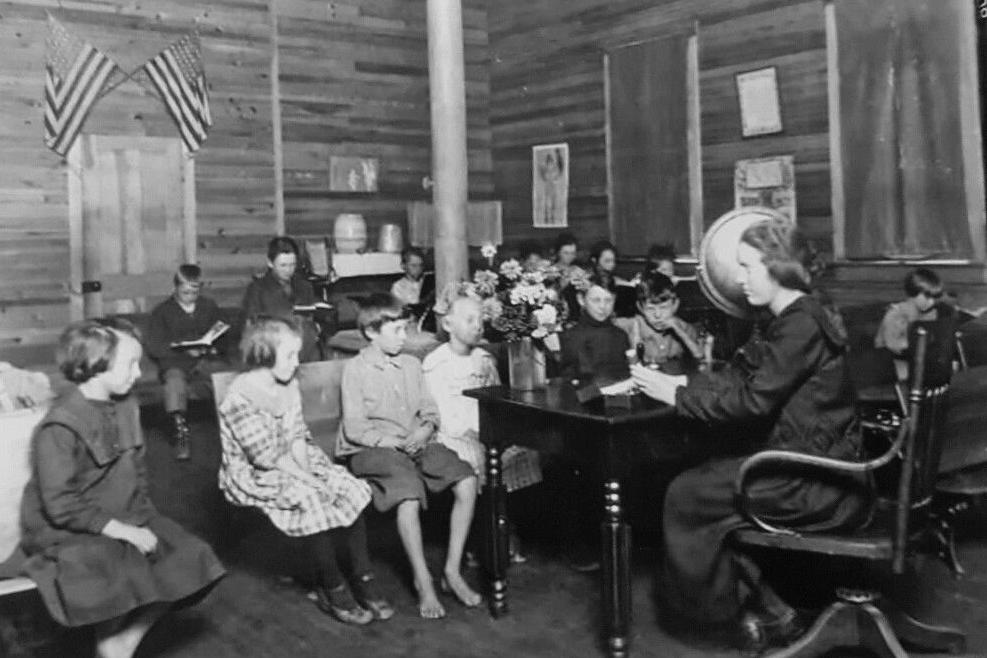
United States School Types: School Sizes--Chronology

Figure 1.--This photograph shows the inside of a one room school. Unfortunately we do not know where it was located, although we would guess somewhere in the South. This teacher had 15 students. The clothing suggests it was taken in 1910s. Notice the American flags are on top of the door and a globe on the teachers desk. Also notice the stove pipe in the middle of the room. You can't see the stove, but that was how the school was heated in the winter. Notice the jug and bucket for water at the back.
|
|
American schools vary greatly in size and this has changed over time. The bsic trend was that a time went on, schools got larger and larger. Even city schools were very small compared to modern schools. American schools from a very early point included many very small schools. This was because the Northwest Ordinance which dividedup the western lands provided for schools all over rural America all the way to the Missisippi. The schools were small and often basic, but they were schools and learning taking place on the frontier. The Homesteead Act continued the same system further west. This mean that small, often, one-room schools appeared all over America as the frontier moved west. These early schools were very basic, but there were schools throughout the North from the earliest days. Families differed as to their commitment to education and economic circumstances to support education for their children, but few children in the North did not have access to basic primary education. The South was somewhat different. Southern states tended to be less committed to public education. And many of these small schools continued to operate into the the 20th century. As cities and towns grew you begin to get larger schools, not only becuse of the urbanization, but because more and more children were going to school longer and achieving higher levels of education. But even in towns, many high schools continued to be very small until after World War II when school systems began to consolidate and bussing children became standard practice. It is at this time that you begin to get larger schools and the small rural schools begin to disappear.
HBC-SU

Related Chronolgy Pages in the Boys' Historical Web Site
[Main Chronology Page]
[The 1900s]
[The 1910s]
[The 1920s]
[The 1930s]
[The 1940s]
[The 1950s]
[The 1960s]
[The 1970s]
[The 1980s]
[The 1990s]
[The 2000s]
Navigate the Relate Boys Historical Clothing Style Pages
[Main country page]
[Long pants suits]
[Short pants suits]
[Lederhosen]
[Kneesocks]
[Eton suits]
[Jacket and trousers]
[Blazer
[School sandals]
Navigate the HBC Country School Pages
[Return to the Main National School Page]
[Return to the Main School Page]
[Australia]
[England]
[France]
[Germany]
[Ireland]
[Italy]
[Japan]
[New Zealand]
[Poland]
[Singapore]
[Scotland]
[Singapore]
[United States]
Navigate the HBC School Section
[Return to the Main U.S. School Size Page]
[Return to the Main U.S. School Type Page]
[Return to the Main U.S. school page]
[About Us]
[Activities]
[Chronology]
[Clothing styles]
[Countries]
[Debate]
[Economics]
[Garment]
[Gender]
[Hair]
[History]
[Home trends]
[Literary characters]
[School types]
[Significance]
[Transport and travel
[Uniform regulations]
[Year level]
[Other topics]
[Images]
[Links]
[Registration]
[Tools]
[Return to the Historic Boys' School Home]
Created: 9:11 PM 12/3/2016
Last updated: 9:11 PM 12/3/2016




